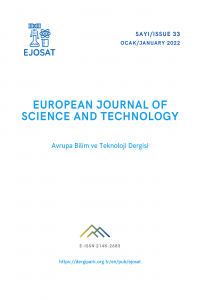Abstract
Yüz verilerini sınıflandırma işlemi, üzerinde çok sayıda çalışma yapılan derin öğrenme konularından birisidir. Bu konuda evrişimli sinir ağları, kolay uygulanabilir olmaları ve başarılı sonuçlar vermeleri nedenlerinden ötürü tercih edilen derin öğrenme uygulamalarının başında gelmektedir. Buna karşın evrişimli sinir ağlarında bulunan havuzlama katmanı verilerde bilgi kaybına neden olmaktadır. Ayrıca evrişimli sinir ağları, verideki bileşenlerin birbirine göre durumlarını göz ardı ederek eğitim işlemini gerçekleştirmektedir. Bu duruma çözüm olarak kapsül ağları önerilen derin öğrenme yöntemlerindendir.
Bu çalışmada; 5 kişinin her biri için 200 veriden oluşan, toplam 1000 görüntü verisi içeren bir veri seti hazırlanmıştır. Hazırlanan veri seti ile sıkça kullanılan evrişimli sinir ağı yöntemlerinden olan AlexNet, Vgg16, Vgg19, ResNet50 algoritmalarının her biri ve önerilen kapsül ağlar yöntemi kullanılarak eğitim işlemi yapılmıştır. Yapılan çalışmanın sonucunda evrişimli sinir ağı yöntemlerinin başarımları ile kapsül ağlar yönteminin başarımları karşılaştırılmıştır.
Keywords
Supporting Institution
Fırat Üniversitesi
Project Number
MF.21.54
Thanks
Bu çalışma, Fırat Üniversitesi MF.21.54 numaralı Bilimsel Araştırma Projesi kapsamında desteklenmiştir.
References
- Beser, F., Kizrak, M. A., Bolat, B., Yildirim, T. (2018). Kapsül Ağları ile İşaret Dili Tanıma Recognition of Sign Language using Capsule Networks. 26th Signal Processing and Communications Applications Conference (SIU), 1-4. doi:10.1109/SIU.2018.8404385.
- Doğan, F. ve Türkoğlu, İ. (2018). Derin Öğrenme Algoritmalarının Yaprak Sınıflandırma Başarımlarının Karşılaştırılması. Sakarya University Journal of Computer and Information Sciences, 1(1), 10-21.
- He, K., Zhang, X., Ren, S. and Sun, J. (2016). Deep residual learning for image recognition. In Proceedings of the IEEE conference on computer vision and pattern recognition, 770- 778.
- İnik, Ö., Ülker, E. (2017). Derin Öğrenme ve Görüntü Analizinde Kullanılan Derin Öğrenme Modelleri. Gaziosmanpaşa Bilimsel Araştırma Dergisi, 6(3), 85-104.
- Kınlı, F., Kıraç, F. (2020). FashionCapsNet: Clothing Classification with Capsule Networks. Bilişim Teknolojileri Dergisi, 13(1), 87-96. doi:10.17671/gazibtd.580222.
- Krizhevsky, A., Sutskever, I., and Hinton, G. E. (2012). ImageNet Classification with Deep Convolutional Neural Networks. Advances in Neural Information Processing Systems, 25.
- Özyurt, F., Tuncer, T., Avci, E., Koç, M., Serhatlioğlu, İ. (2019). A Novel Liver Image Classification Method Using Perceptual Hash-Based Convolutional Neural Network. Arab J Sci Eng, 44(4), 3173–3182. doi: 10.1007/s13369-018-3454-1.
- Öztürk, Ş., & Özkaya, U. (2020). Skin lesion segmentation with improved convolutional neural network. Journal of digital imaging, 33(4), 958-970. doi: 10.1007/s10278-020-00343-z.
- Sabour, S., Frosst, N. and Hinton, G. E. (2017). Dynamic Routing Between Capsules. arXiv preprint, arXiv:1710.09829.
- Simonyan, K., and Zisserman, A. (2014). Very deep convolutional networks for large-scale image recognition. arXiv preprint. arXiv:1409.1556.
- Toğaçar, M., Ergen, B., Cömert, Z., Özyurt, F. (2020). A Deep Feature Learning Model for Pneumonia Detection Applying a Combination of mRMR Feature Selection and Machine Learning Models. IRBM, 41(4), 212-222. doi: 10.1016/j.irbm.2019.10.006.
- Toraman, S. (2020). Kapsül Ağları Kullanılarak EEG Sinyallerinin Sınıflandırılması. Fırat Üniversitesi Mühendislik Bilimleri Dergisi , 32(1) , 203-209. doi: 10.35234/fumbd.661955.
Abstract
The process of classifying facial data is one of the deep learning topics that has been studied extensively. In this regard, convolutional neural networks are among the most preferred deep learning applications because they are easy to implement and give successful results. On the other hand, the pooling layer in convolutional neural networks causes information loss in the data. In addition, convolutional neural networks perform the training process by ignoring the relative states of the components in the data. As a solution to this situation, capsule networks are one of the recommended deep learning methods.
In this study; A data set consisting of 200 data for each of the 5 people and a total of 1000 image data was prepared. With the prepared data set, each of the AlexNet, Vgg16, Vgg19, ResNet50 algorithms, which are frequently used convolutional neural network methods, and the proposed capsule network method were used for training. As a result of the study, the performances of the convolutional neural network methods and the performances of the capsule networks method were compared.
Project Number
MF.21.54
References
- Beser, F., Kizrak, M. A., Bolat, B., Yildirim, T. (2018). Kapsül Ağları ile İşaret Dili Tanıma Recognition of Sign Language using Capsule Networks. 26th Signal Processing and Communications Applications Conference (SIU), 1-4. doi:10.1109/SIU.2018.8404385.
- Doğan, F. ve Türkoğlu, İ. (2018). Derin Öğrenme Algoritmalarının Yaprak Sınıflandırma Başarımlarının Karşılaştırılması. Sakarya University Journal of Computer and Information Sciences, 1(1), 10-21.
- He, K., Zhang, X., Ren, S. and Sun, J. (2016). Deep residual learning for image recognition. In Proceedings of the IEEE conference on computer vision and pattern recognition, 770- 778.
- İnik, Ö., Ülker, E. (2017). Derin Öğrenme ve Görüntü Analizinde Kullanılan Derin Öğrenme Modelleri. Gaziosmanpaşa Bilimsel Araştırma Dergisi, 6(3), 85-104.
- Kınlı, F., Kıraç, F. (2020). FashionCapsNet: Clothing Classification with Capsule Networks. Bilişim Teknolojileri Dergisi, 13(1), 87-96. doi:10.17671/gazibtd.580222.
- Krizhevsky, A., Sutskever, I., and Hinton, G. E. (2012). ImageNet Classification with Deep Convolutional Neural Networks. Advances in Neural Information Processing Systems, 25.
- Özyurt, F., Tuncer, T., Avci, E., Koç, M., Serhatlioğlu, İ. (2019). A Novel Liver Image Classification Method Using Perceptual Hash-Based Convolutional Neural Network. Arab J Sci Eng, 44(4), 3173–3182. doi: 10.1007/s13369-018-3454-1.
- Öztürk, Ş., & Özkaya, U. (2020). Skin lesion segmentation with improved convolutional neural network. Journal of digital imaging, 33(4), 958-970. doi: 10.1007/s10278-020-00343-z.
- Sabour, S., Frosst, N. and Hinton, G. E. (2017). Dynamic Routing Between Capsules. arXiv preprint, arXiv:1710.09829.
- Simonyan, K., and Zisserman, A. (2014). Very deep convolutional networks for large-scale image recognition. arXiv preprint. arXiv:1409.1556.
- Toğaçar, M., Ergen, B., Cömert, Z., Özyurt, F. (2020). A Deep Feature Learning Model for Pneumonia Detection Applying a Combination of mRMR Feature Selection and Machine Learning Models. IRBM, 41(4), 212-222. doi: 10.1016/j.irbm.2019.10.006.
- Toraman, S. (2020). Kapsül Ağları Kullanılarak EEG Sinyallerinin Sınıflandırılması. Fırat Üniversitesi Mühendislik Bilimleri Dergisi , 32(1) , 203-209. doi: 10.35234/fumbd.661955.
Details
| Primary Language | Turkish |
|---|---|
| Subjects | Engineering |
| Journal Section | Articles |
| Authors | |
| Project Number | MF.21.54 |
| Early Pub Date | January 30, 2022 |
| Publication Date | January 31, 2022 |
| Published in Issue | Year 2022 Issue: 33 |


